Prairies are made of numerous types of grasses, sedges, broad-leaved plants and even some trees.
Prairies have their own characteristic plants, some of which grow only on the prairie and some
that are common in fields, pastures and along roadsides.
There are three types of land in a prairie--the open prairie, woods and savannah. Open prairies can
have as many as 400 kinds of plants in a single prairie, with flowers blooming from late April
through October. The variety of shapes and colors is almost unbelievable. These plants have
adapted to prairie soils by growing long and very complex root systems, forming a dense carpet of
vegetation. This discourages foreign plants and keeps the prairie stable. Fires burning the prairies
do not harm the deep root systems which keep the prairie plants coming back, whereas fires kill or
stunt trees.
Wooded areas are mostly along streams and on the edges of the prairie where there is more water
and less fire. There's a constant war between the open prairie and the woodland plants. The areas
between the prairie and woods is called savannah where prairie plants grow into woods and
woods invade prairie. Most of the trees in savannahs have corky bark that can withstand fires. If
there is a four or five year period with a lot of rain, there will be few fires, and the woods will
creep in and thrive, but if there are a few fires in early spring, the prairie grasses will flourish.
Burning in March will assure the plants growing back by May.
Prairie grasses are called warm season grasses, and continue to grow into late summer and early
fall. There are several different types of grasses on the prairie. Among the most common are big
and little bluestem, switchgrass and Indian grass, although there are over fifty other grass species
that are less common than these.
Following are a few of the many flowering plants found on Ozark prairies. The local common
name (arranged alphabetically) is followed by the scientific name, the flower's blooming period, a
:general description of the plant and what, if anything, the plant is used for by man.
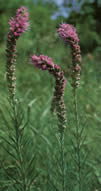
5--Blazing Star |
Blazing Star [Liatris pycnostachya] July-October
This is a tall, slender plant often called gay feather, growing from
one to six feet tall with thick heads of small purple blossoms that grow
along a single stalk. The flowers are on thin spikes on the upper eighteen
inches of the stalk. The heads are surrounded by modified leaves that
are the same color as the flowers. The leaves are very narrow, up to
four inches long. It was formerly used as a snakebite antidote, but its
anti-venom properties are not proven. (See ill. 5) |
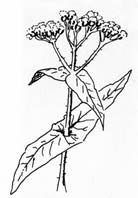
11--Boneset |
Boneset [Eupatorium perfoliatum] July-October
The small, white flowers are in flat-topped heads. The toothed leaves
on opposite sides of the stem join or sort of join together. The pioneers
believed that a tea made out of this would set bones because it set the
leaves together. Boneset occurs in moist depressions and low areas on
Ozark prairies. (See ill.11) |
| [15] |
|

14--Butterfly Weed |
Butterfly Weed (Asclepia tuberosa) May-September
This one to three foot plant has brilliant orange flat topped blossoms
at the top of the stem. The leaves are hairy and dark green. It is a
milkweed with a non-milky sap. It is a very adaptable, resistant and
aggresive prairie plant, frequently invading old fields and growing along
roadsides. Pioneers used the roots in medicine. (See ill.14) |

26--Compass Plant |
Compass Plant (Silphium laciniatum) July-September
One of the taller prairie plants, compass plant, ranging up to nine
feet tall, is easily recognized by the big yellow flowers along the long
stalk and basal, deeply cleft leaves that point north and south to get
the maximum sun exposure. The settlers used it for telling directions
because the leaves always pointed north and south. The sticky resin on
the flowering stalks was used as chewing gum by the Indians. (See ill.26) |

6--Cream Wild Indigo |
Cream Wild Indigo (Baptisia leucophaea) April-June
This pretty plant has clumps of cream-colored flowers similar to peas.
It is low and bushy, growing to twelve inches. The leaves will turn black
if they are picked or damaged. The whole plant turns black when dried.
The settlers used it as a dye, for crumbled up and boiled, it turns the
water blue. This was not as good a dye as the indigo that came from the
Caribbean Islands, but it worked. (See ill.6) |
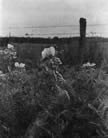
15--Goat's Rue |
Goat's Rue (Tephrosia virginiana) May-August
This member of the pea family has two-toned flowers--yellow above and
pink below. The leaves are on a small stem similar to sensitive plant
with eight to fourteen pairs of leaflets and one at the tip. Its roots
are a source of rotenone which Indians used as fish poison. (See ill.15) |
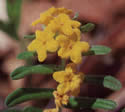
27--Hoary Puccoon |
Hoary Puccoon (Lithospermum canescens) March-June.
The clusters of orange flowers have five petals coming from a small
tube. The hairy slender leaves alternate and are toothless. The hairy
stalks are six to ten inches. (See ill.27) |

7--Indian Paint Brush |
Indian Paint Brush (Castilleja coccinea) April-July
This popular prairie flower growing eight to fifteen inches in height
has colored leaves at the top to attract insects to its flowers which
are inconspicuous and drab. Indian paint brush is in the snapdragon family.
(See ill.7) |

8--Ladies Tresses |
Ladies Tresses (Spiranthes cernua) Late summer-fall
This is an orchid found in prairies and old fields. The flowers occur
in a spiraling arrangement on the stem which grows to eighteen inches.
They bloom in the late fall when most other flowers are dead. It is called
ladies tresses because it resembles the spiral tresses of a lady's hair.
(See ill.8) |

16--Lead Plant |
Lead Plant (Amorpha canescens) May-August
This plant is common in prairies and glades in Missouri. The flowers
are in a long cluster and are violet or purple in color with bright yellow
stamens. The hairy leaves on the lead plant are a silvery gray which
gives it a leaden color. The color is one theory for how it may have
got its name. Another theory for its name was derived from its use in
finding lead deposits. Near Galena, Illinois, which was one of the first
lead producing areas in the Mid-west, prospectors looked for lead deposits
by looking for the lead plant. Lead deposits were found under glacial
hill areas and prairies where the soil was shallow. That's where lead
plants grow. (See ill.16) |
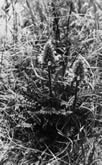
17--Lousewort |
Lousewort (Pedicularis canadensis) April-May
The tubular, hooded flowers are yellow, growing in a broad whorl on
top of a short plant. The plant is six to ten inches tall when flowering.
The long, soft, hairy leaves are deeply toothed and fern-like. This plant
is in the snapdragon family. (See ill.17) |
| [16] |
|

18--Milkweed |
Milkweed (Asclepias hirtella) May-August
At first glance, this plant looks like a common milkweed found along
a roadside, but a closer examination will disclose the smaller and whiter
individual flowers and narrower leaves. The leaf has a rose-pink line
running through it, and the entire plant is hairy. Many other kinds of
milkweed are found in prairies. (See ill.18) |

19--Pale Beard Tongue |
Pale Beard Tongue [Pentstemon pallidus] May-July
Small white tubular flowers cluster at the top of a three to four foot
stem. The pointed leaves join across the stem from each other. The common
name comes from the wooly surface of the pollen-producing organs in flower
which resemble a hairy tongue. (See ill.19) |
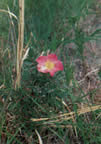
9--Pasture Rose |
Pasture Rose [Rosa carolina] June-July
This wild rose is common in open sunny areas, including prairies, glades,
fields and roadsides. It has large pink flowers and thorns. The leaflets
are in sets of threes. (See ill. 9) |

10--Prairie Blue-Eyed Grass |
Prairie Blue-eyed Grass [Sisyrinchium campestre] May-June
The small blue flowers have six petals tipped with small points. They
are on wiry flattened stems that grow four to twenty-four inches tall,
with grasslike leaves. The leaves and height are similar to yellow star
grass, but the flowers are smaller and blue. (See ill.10) |

28--Cone Flower |
Purple Cone Flower [Echinacea pallida] May-July
This well known prairie plant has a showy purple flower with drooping
petals on a long stem with the leaves at the base. The stem and the leaves
have rough scratchy hairs on them. (See ill.28) |

29--Rattlesnake Master |
Rattlesnake Master [Eryngium yuccifolium]
A member of the parsley family, this plant looks like a yucca with little
spines along the edges of the leaves which are three to twelve inches
long. The flower clusters are globe like, greenish-white, at the end
of a long stem which grows up to five feet tall. The ball-shaped flowering
heads consist of tiny, five-part bluish flowers. One way it might have
got its name is that when the dried flowering heads are shaken, they
make a rattling sound like a rattlesnake. There are several myths about
the plant. Not only do the seeds sound like a rattlesnake, but some say
the rattlesnake is afraid of the sound, and that eating the heads will
cure poisoning from rattlesnakes. (See ill.29) |
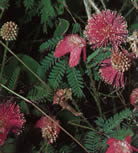
20--Sensitive Brier |
Sensitive Brier [Schrankia uncinata] May-September
Though found on the prairies, this plant is also found in other habitats.
It is easily identified by the double compound leaves that fold up when
touched. It has lavender or pink hairlike ball-shaped flowers and prickly
stems. The seeds are sometimes used as a laxative. (See ill.20) |

21--Shooting Star |
Shooting Star [Dodecatheon meadia] April-June
Its flowers are usually lavender, white or red, often with yellow centers,
pointing downward with the petals swept back. The flowers are clustered
at the top of a leafless long stem. The stem grows to two and a half
feet with the broad leaves at the base. (See ill.21) |

22--Spiderwort |
Spiderwort [Tradescantia ohiensis] May-July
This is a different looking plant. The leaf comes out right under the
clusters of purple flowers. It grows well on roadsides, railroads as
well as other places. There are several species of spiderwort, but the
prairie species is taller than most of them, being up to three feet tall.
Spiderwort flowers are very sensitive to certain types of pollution and
are sometimes used as monitors. (See ill.22) |

23--Stiff Coreopsis |
Stiff Coreopsis [Coreopsis palmata] June-July
The bright yellow flowers with each petal having three points or teeth
on the end grow on stems one to three feet tall. It is often called tickseed
because the seed looks like a tick. (See ill.23) |
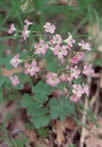
24--Violet Wood Sorrel |
Violet Wood Sorrel [Oxalis violacea] April-July and September-October
This delicate plant has cloverlike, heart-shaped leaves in threes, with
delicate violet. The sour leaves are used in salads. The roots are eaten.
(See ill.24) |
| [19] |
|
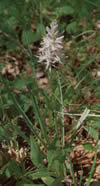
25--Wild Hyacinth |
Wild Hyacinth [Camassia scilloides] April-May
The tiny, light blue flowers with six petals are on a stalk one to two
feet tall. The leaves are grass-like. It grows in the more open or naturally
disturbed areas of a prairie, such as along game trails or on slopes.
(See ill.25) |

13--Wild Quinine |
Wild Quinine, or American Feverfew [Parthenium integrifolium]
May-September
The plant, about three feet tall, has heads of small white flowers.
The large leaves are irregularily toothed. It was formerly used by the
pioneers to quell fevers. The plant contains a chemical principle that
is very similar to quinine. Even today people that believe in folk medicine
use it rather than aspirin. (See ill.13) |

30---Yarrow |
Yarrow [Achillea millefolium] May-November
This plant, which grows up to three feet tall, has white flowers in
dense flattish clusters at the top of a long stem. The narrow leaves
are fern-like, about ten inches long. It has a strong odor. Yarrow is
a useful plant--one that the folklore medicine stories about it are justified
because it is a antibiotic that kills germs. The Indians used to pack
wounds with it. Since its sap coagulates human blood, it will stop a
bleeding wound. (See ill.30) |

31--Yellow Flax |
Yellow Flax [Linum sulcatum] May-September
Common on glades and in dry open prairies, often in acid soil, this
plant grows up to two feet tall. It has narrow inconspicuous leaves and
large pale yellow flowers on tiny smooth stems. A cultivated relative
of this plant is used to make linen cloth and linseed oil. (See ill.
31) |
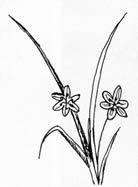
12--Yellow Star Grass |
Yellow Star Grass [Hypoxis hirsuta] April-May, sometimes
in fall
This member of the daffodil family is a disturbance-resistant prairie
plant that persists in old fields where there was an original prairie
matrix. It looks like a grass, but has yellow flowers about a half inch
across on thread-like, hairy stems which grow up to six inches tall.
(See ill.12) |
Appreciation goes to Doug Ladd, Naturalist, Bennett Spring State Park for
help on the two
prairie articles and for photos 5, 8, 10, 20, 25, 26, 27, and 29.
Copyright © 1981 BITTERSWEET, INC.

